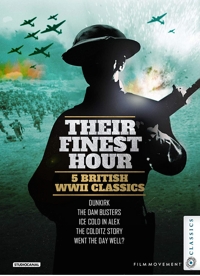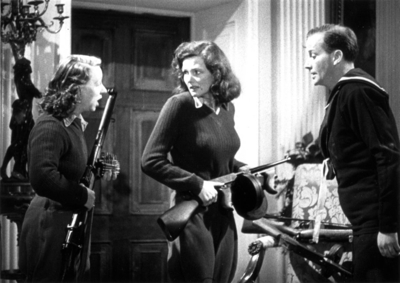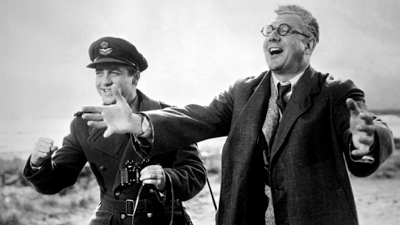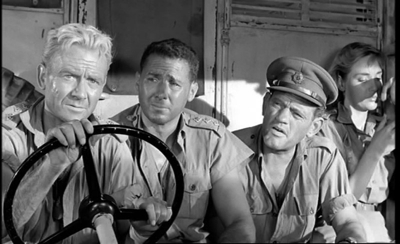 Grade: B+
Grade: B+
Not rated (would be PG)
War / drama
British WWII movies were dependably good, so it’s no surprise that this collection of five black-and-white films doesn’t contain a single stinker. Every one of them is in the B range. Because of patriotic undertones and because of the era they tend to be on the melodramatic side, but they stick with you as much as those distinctive vocal harmonies from the ‘40s.
Went the Day Well? has a title that sounds stiff, and in fact all of the older women in this 1942 film seem to talk in the same proper, lilting, slightly theatrical voice as Aunt Bee from the old Andy Griffith Show. One of the strongest films in this collection, it’s a home guard movie based on a Graham Greene story about residents of a small British village who are asked to “billet” a platoon of soldiers. Some soldiers are put up at homes and others in a town hall converted into a dorm. But the residents start to suspect that some of those soldiers aren’t at all  proper British. Could they be Nazi sympathizers? Or has wartime made everyone overly cautious? Like other films in this collection it’s a bit of a slow simmer but a fascinating drama that might appeal to older children because of the “what if” questions implied by the scenario and because some of the key characters are children. This one’s a B+, with the added bonus of being shot during wartime, when studios couldn’t build new sets and therefore used more location filming with available buildings. As a result, you get a pretty fair idea of what life looked and felt like in 1942.
proper British. Could they be Nazi sympathizers? Or has wartime made everyone overly cautious? Like other films in this collection it’s a bit of a slow simmer but a fascinating drama that might appeal to older children because of the “what if” questions implied by the scenario and because some of the key characters are children. This one’s a B+, with the added bonus of being shot during wartime, when studios couldn’t build new sets and therefore used more location filming with available buildings. As a result, you get a pretty fair idea of what life looked and felt like in 1942.
The Colditz Story is directed by Guy Hamilton, who’s best known for directing a quartet of James Bond films. But nine years before he worked with Sean Connery on Goldfinger he directed the first adaptation of P.R. Reid’s The Colditz Story—a true account of allied prisoners of various nationalities that tried again and again to escape from “escape-proof” Colditz Castle. While solid, this 1955 film doesn’t have the same epic feel of more accomplished POW films like Bridge on the River Kwai, Von Ryan’s Express, or The Great Escape. Because  it’s episodic rather than building to one big moment and also blends in moments of comedy, it comes closer to the tone and range of Stalag 17—though again, not as accomplished. Still, John Mills, Christopher Rhodes and the others turn in convincing performances, while Hamilton manages to create tense sequences despite the seemingly lower stakes. Unlike more destitute camps that produce more desperate prisoners, these captives are housed in castle rooms and they have daily soccer games and other diversions. They’re forever making fun of their captors—though not nearly to the same degree as the later popular TV series Hogan’s Heroes. With no prisoners tortured or starved and very few shot while trying to escape, this POW film is better suited for general audiences than the other prisoner-of-war movies. It’s a solid B film, presented in 16×9 format (altered from the original 1.37:1).
it’s episodic rather than building to one big moment and also blends in moments of comedy, it comes closer to the tone and range of Stalag 17—though again, not as accomplished. Still, John Mills, Christopher Rhodes and the others turn in convincing performances, while Hamilton manages to create tense sequences despite the seemingly lower stakes. Unlike more destitute camps that produce more desperate prisoners, these captives are housed in castle rooms and they have daily soccer games and other diversions. They’re forever making fun of their captors—though not nearly to the same degree as the later popular TV series Hogan’s Heroes. With no prisoners tortured or starved and very few shot while trying to escape, this POW film is better suited for general audiences than the other prisoner-of-war movies. It’s a solid B film, presented in 16×9 format (altered from the original 1.37:1).
The Dam Busters came out in 1955 and I saw it as a youngster. I still remembered the low-flying planes skipping bombs across the water like giant beach balls, but I did remember the run-up to the action: an engrossing story of scientist (Michael Redgrave) who attacks the problem with all the eccentric calm of Disney’s Absent-Minded Professor. It’s a war movie that doesn’t have killing, and doesn’t really have much action. Mostly it’s the story of one man’s persistence and then the dedication of the main pilot (Richard Todd) charged with  guiding his 617 Squadron to carry out the mission. Though the film was Oscar-nominated for special effects that mostly look good, be warned that there’s one shot of a burst dam that looks more like emulsion spreading quickly over film. No matter. This one is compelling for the story itself and a great choice for family viewing if you can overlook one unfortunate detail. The unfortunate name that Wing Commander Guy Gibson (Todd) gave his black dog is the “n” word, and the handful of times that someone calls him by name make you cringe. Nonetheless, it’s a solid bit of cinematic storytelling and would have been a B+ were it not for the dog. But it’s still a B-.
guiding his 617 Squadron to carry out the mission. Though the film was Oscar-nominated for special effects that mostly look good, be warned that there’s one shot of a burst dam that looks more like emulsion spreading quickly over film. No matter. This one is compelling for the story itself and a great choice for family viewing if you can overlook one unfortunate detail. The unfortunate name that Wing Commander Guy Gibson (Todd) gave his black dog is the “n” word, and the handful of times that someone calls him by name make you cringe. Nonetheless, it’s a solid bit of cinematic storytelling and would have been a B+ were it not for the dog. But it’s still a B-.
Dunkirk is the most conventional war movie of this bunch. Released in 1958, this first fictionalized account of the famous evacuation of trapped British soldiers stars John Mills and Richard Attenborough. More traditional in its storytelling than Christopher Nolan’s 2017 film, director Leslie Norman’s film is still fascinating from start to finish and it also has some interesting resonances. In Britain there was little support for the war early on. In fact, as a precursor to Trump’s cries of “fake news” and “hoaxes,” this first eight months of the conflict it was  dubbed “The Phony War,” and this film begins with a journalist’s frustrations that the public will not rouse. But it ends, of course, with a dramatic civilian rescue of British soldiers who were trapped at the seaport of Dunkirk and surrounded on all sides by the enemy. Mills plays a corporal in the thick of things, while Attenborough is a garage owner who also operates a small factory and reluctantly (then gallantly) leaves on his boat to do his part to evacuate troops. Nolan’s story was a collage of impressionistic you-are-there sensory images—a creative approach that helps you feel what it’s like to be right there in the thick of things. But for a really well-done standard narrative approach, this 1958 Dunkirk makes for a moving wartime adventure that rates a B/B+.
dubbed “The Phony War,” and this film begins with a journalist’s frustrations that the public will not rouse. But it ends, of course, with a dramatic civilian rescue of British soldiers who were trapped at the seaport of Dunkirk and surrounded on all sides by the enemy. Mills plays a corporal in the thick of things, while Attenborough is a garage owner who also operates a small factory and reluctantly (then gallantly) leaves on his boat to do his part to evacuate troops. Nolan’s story was a collage of impressionistic you-are-there sensory images—a creative approach that helps you feel what it’s like to be right there in the thick of things. But for a really well-done standard narrative approach, this 1958 Dunkirk makes for a moving wartime adventure that rates a B/B+.
Ice Cold in Alex is another 1958 movie and another one that most people won’t have heard of. It stars John Mills, Sylvia Syms, Anthony Quayle, and Harry Andrews in an offbeat wartime adventure set in the North African desert, where WWII was fought with tanks and half-tracks and men wearing khaki shorts. Like The Dam Busters and Went the Day Well? it’s a wartime movie without a lot of war in it. Mills plays a commanding officer of a British RASC Motor Ambulance Company who hasn’t been the same since he escaped from the enemy. He’s been  showing the effects of PTSD and drinking heavily, but insists on being the one to take two stranded nurses to their unit after they are all ordered to evacuate to Alexandria. Along the way they pick up a South African officer (Quayle) who is protective of his pack and carries gin—something that the commander’s faithful second-in-command sees as a threat to his friend. Along the way they have run-ins with the enemy, with minefields, with nature, and with each other, making it more of a survival-in-the-wilderness epic than a standard war movie. Like others in this collection, though, the plot and moments in the film will stick with you long afterwards. As a character drama and gauntlet adventure, it’s another solid B+ and tied with Went the Day Well? for best of this bunch. It’s also presented in 16×9 format.
showing the effects of PTSD and drinking heavily, but insists on being the one to take two stranded nurses to their unit after they are all ordered to evacuate to Alexandria. Along the way they pick up a South African officer (Quayle) who is protective of his pack and carries gin—something that the commander’s faithful second-in-command sees as a threat to his friend. Along the way they have run-ins with the enemy, with minefields, with nature, and with each other, making it more of a survival-in-the-wilderness epic than a standard war movie. Like others in this collection, though, the plot and moments in the film will stick with you long afterwards. As a character drama and gauntlet adventure, it’s another solid B+ and tied with Went the Day Well? for best of this bunch. It’s also presented in 16×9 format.
Some people are history buffs, some people are into old movies, and some people like war movies. This solid collection—with great Blu-ray transfers, five additional documentaries, interviews, archival footage, and even home movies shot by Mills—will seem like a real treasure to those people.
Entire family: No (10 and older)
Run time: 572 min., black-and-white
Studio/Distributor: StudioCanal/Film Movement
Aspect ratio: 1.37:1 and 1.66:1
Featured audio: Dolby Digital Mono
Bonus features: A-
Trailer
Amazon link
Language: 3/10—No f-bombs, and comparatively fewer lesser swearwords in these five films
Sex: 0/10—Nothing, really
Violence: 5/10—People are shot and there are explosions, but it’s all pretty mild compared to today’s war movies
Adult situations: 5/10—Lots of smoking (it’s the ‘40s and ‘50s) and some drinking, with the excess coming only in Ice Cold in Alex
Takeaway: StudioCanal and Film Movement really came up with a nice thematic grouping here, and John Mills fans will be especially pleased with this set


Leave a comment